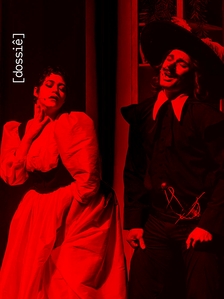The process of creating costumes for a video game and the importance of professionals in the field
DOI:
https://doi.org/10.26563/dobras.v18i43.1882Keywords:
Character design, Historical reinterpretation, Realistic video game, 3D animation, Costume designerAbstract
This article demonstrates the importance of the costume designer or fashion designer role in the development of characters and aesthetics in the 3D animation and video game industry. The analysis of the approach in the creation experience of the costume designer Heli Salomaa (2018) in the digital environment. Through a developed project for a video game test, the research methods, creation and graphic communication of costume design for four characters with thematic reference to celtic culture and futuristic environment are presented — just like the visual development artist, present professional work in creations in the digital 3D animation and video games. The theoretical basis is also based on interviews with professionals working in the field and articles related to the use of 3D development software. It aims to analyse the tools used and identify the importance of a skilled professional, as well as the changes that are emerging in the market.
Downloads
References
CARTWRIGHT, Mark. Ancient Celts. World History Encyclopedia, Apr. 2021. Disponível em: https://www.worldhistory.org/celt/. Acesso em: 29 jul. 2024.
KALMAKURKI, Maarit. Digital character costume design in computer-animated feature films. 2021. Tese (School of Arts, Design and Architecture Doctoral thesis) – Department of Film, Television and Scenography – Aalto University, Espoo, Finland, 2021. Disponível em: https://aaltodoc.aalto.fi/items/4920a810-26bf-462b-ab1a-8aa6d2f536fd. Acesso em: 29 jul. 2024.
KINNUNEN, Krista. Costume designers can add significant value to animated films. Aalto University, [s. l.], dec. 2021. Disponível em: https://www.aalto.fi/en/news/costume-designers-can-add-significant-value-to-animated-films. Acesso em: 12 fev. 2024.
KLASTRUP, Lisbeth; TOSCA, Susana. “Because it just looks cool!” Fashion as character performance: The Case of WoW. Journal of Virtual Worlds Research, [s. l.], v. 1, n. 3, fev. 2009. Disponível em: https://evols.library.manoa.hawaii.edu/items/4b43884b-5b5d-4483-9aab-b4cf7a53fa21. Acesso em: 29 jul. 2024.
JOHN, Bettina. Costume Design for Performance. Wiltshire: The Crowood Press Ltd, 2021.
LYONS, Sandy A. (ed.). Costume Design for Video Games: An Exploration of Historical and Fantastical Skins. 1. ed. Boca Raton: CRC Press, 2020.
POELS, Karolien; DE KORT, Yvonne; IJSSELSTEIJN, Wijnand. “It is always a lot of fun!”: exploring dimensions of digital game experience using focus group methodology. In: PROCEEDINGS OF THE 2007 CONFERENCE ON FUTURE PLAY, 7., 2007, New York. Anais [...].New York: Association for Computing Machinery, 14 nov. 2007. Disponível em: https://doi.org/10.1145/1328202.1328218. Acesso em: 29 jul. 2024.
REMEDY GAMES. Creating a character’s look. 2017. Disponível em: https://www.remedygames.com/creating-a-characters-look. Acesso em: 22 de jan. de 2022.
SALOMAA, Heli. Video games and costume art: digitalizing analogue methods of costume design. 2018. 104f. Thesis (Master’s of Arts) – School of Arts, Design and Architecture, Aalto University, Espoo-Finlândia, 2018.
SNYDER, Chris; PHILLIPS, Ian. How Disney’s animation evolved from “Frozen” to “Frozen 2”. Business Insider. 1 vídeo (13 min). 2019. Disponível em: https://www.businessinsider.com/how-disney-frozen-2-was-animated-2019-12. Acesso em: 29 jul. 2024.
TEPE, Jan; KOOHNAVARD, Saina. Fashion and game design as hybrid practices: approaches in education to creating fashion-related experiences in digital worlds. International Journal of Fashion Design, Technology and Education, [s. l.], v. 16, n. 1, p. 37-45, 2 jan. 2023. Disponível em: https://www.tandfonline.com/doi/full/10.1080/17543266.2022.2103591. Acesso em: 29 jul. 2024.

Downloads
Published
How to Cite
Issue
Section
License
Copyright (c) 2025 Clara Pache, Rafaela Norogrando

This work is licensed under a Creative Commons Attribution-NonCommercial-ShareAlike 4.0 International License.
The copyrights of the works published in this journal belong to the author, and dObra[s] holds the rights of first publication. Due to their publication in this open access journal, any work here is free to use, with its own attributions, in educational and non-commercial applications.









